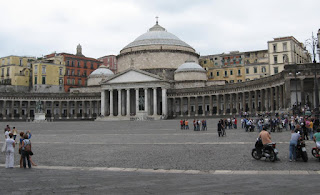Celebrating with a meal of pork and lentils for a prosperous New Year
New Year’s Eve in Italy is known as the Festa di San Silvestro in memory of Pope Sylvester I who died on this day in 335 in Rome.
 |
| New Year celebrations in Rome Photo: Zabbo (CC BY-SA 3.0) |
One custom still followed in some parts of Italy is throwing your old things out of the window at midnight to symbolise your readiness to accept the New Year.
The bars and restaurants are busy with residents and visitors enjoying drinks and meals before seeing in the New Year in the main square when the bells ring at midnight.
Popular menu items include cotechino (Italian sausage), zampone (stuffed pig’s trotter) and lenticchie (lentils).
Pork is said to represent the fullness or richness of life, while lentils are supposed to symbolise wealth or money. Many Italians believe the coming year could bring prosperity if these foods are eaten on New Year’s Eve.
The President of the Republic delivers an end of year message from the Quirinale in Rome, which is shown on most Italian television channels during the evening. There are live concerts in the open air in many squares throughout Italy, some of which are televised.
Sylvester I was pope from 314 until his death in 335, an important time in the history of the Catholic Church.
Some of Rome’s great churches, the Basilica of St John Lateran, the Basilica of the Holy Cross in Jerusalem and the old St Peter’s Basilica, were founded during his pontificate.
.jpg) |
| The Basilica of San Silvestro in Via del Gambero in Rome |
San Silvestro in Capite, the Basilica of Saint Sylvester, is a church in Rome dedicated to Pope Sylvester I. It is in Piazza San Silvestro on the corner of Via del Gambero and Via delle Mercede, on the other side of the Tiber from St Peter’s. Dating from the eighth century, it was bestowed on English Catholics by Pope Leo XIII in 1890. It is now known as ‘The National Church in Rome of Great Britain’ and mass is regularly celebrated in English there.
 |
| The southern Italian hill town of Matera in Basilicata hosts the 2015 New Year's Eve convert on Rai Uno Photo: Giuseppe Rinaldi (CC BY 2.5) |
Travel tip:
Piazza Vittorio Veneto in Matera in the southern region of Basilicata will be the location for the New Year’s Eve concert, ‘L’Anno Che Verrà’ (‘The Coming Year’), which will be shown live on the Italian TV channel Rai Uno from 21.00 tonight (31 December, 2015.) The historic city of Matera is to be the European capital of culture in 2019.
Home





